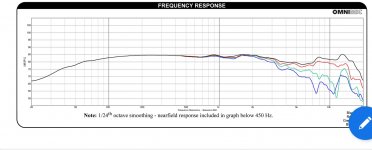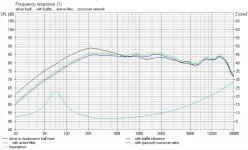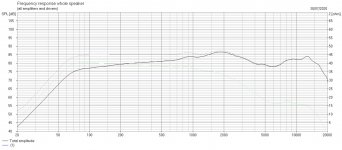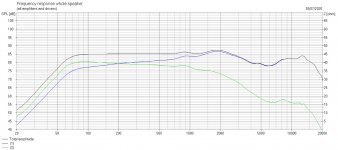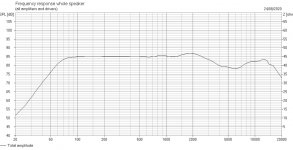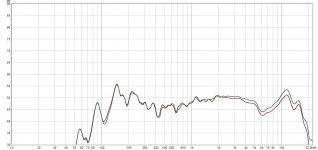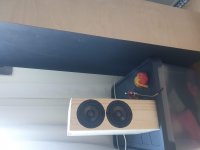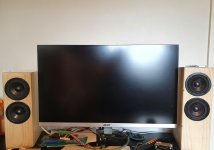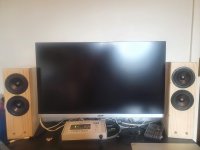Using DSP with full range - two parallel drivers?
Just spinning around an idea about a new build and happened on the Dayton DA115 4" driver.
Original plan was to use it only as a woofer but looking at the FR graph it seems to play almost full range pretty smoothly. Seems like all it would need is little correction in the upper range.
Is it a bad idea to use DSP to correct the upper range and use it as a full range? So far I've only used DSP for lower end corrections where it works nicely. Of course passive crossover could manage as well as the corrections are not overly complicated.
Just spinning around an idea about a new build and happened on the Dayton DA115 4" driver.
Original plan was to use it only as a woofer but looking at the FR graph it seems to play almost full range pretty smoothly. Seems like all it would need is little correction in the upper range.
Is it a bad idea to use DSP to correct the upper range and use it as a full range? So far I've only used DSP for lower end corrections where it works nicely. Of course passive crossover could manage as well as the corrections are not overly complicated.
Attachments
Last edited:
On axis is a bit more crocked in the top than what you see from a tweeter. But extension is OK so why not try? I think it looks like it could work. Cant hurt, can it? 🙂
//
//
I do it passive with an LCR filter to tame the peak in my builds. But i don't see why a dsp would not be able to do that also. But i don't like the sound of pcm processing (like a dsp does) so i keep it analog...
But if you don't mind it, and have a dsp, why not?
But if you don't mind it, and have a dsp, why not?
Thanks for the comments!
My plan is now in motion - just ordered the Zoudio 4ch DSP / Amp for this. I'm going to do this the same way as with my main speakers - room for modifications.
I'll start with a sealed box - 6 liters with dimensions of around 45x20x14cm. These will be placed against the wall so room gain will be significant but I'll keep an option to change these to vented, the volume is pretty good for reflex as well.
The upper range is a question mark - if it's bad I'll add a tweeter in a small separate enclosure on top, the Zoudio luckily has 4 amp channels so there's room to grow.
Attached Boxsim plot in the sealed 6l enclosure.
My plan is now in motion - just ordered the Zoudio 4ch DSP / Amp for this. I'm going to do this the same way as with my main speakers - room for modifications.
I'll start with a sealed box - 6 liters with dimensions of around 45x20x14cm. These will be placed against the wall so room gain will be significant but I'll keep an option to change these to vented, the volume is pretty good for reflex as well.
The upper range is a question mark - if it's bad I'll add a tweeter in a small separate enclosure on top, the Zoudio luckily has 4 amp channels so there's room to grow.
Attached Boxsim plot in the sealed 6l enclosure.
Attachments
Last edited:
If this driver is qualified as woofer because the diaphragm is rigid , it breaks up only at high frequencies. The midrange sound hence the speech goes to background.
If this driver is qualified as woofer because the diaphragm is rigid , it breaks up only at high frequencies. The midrange sound hence the speech goes to background.
I thought so as well, just curious why this doesn't show in the frequency responses measured? There's a midrange dip and a high range wide peak but those are quite small.
Anyway, I'll measure it myself and have a listen to determine if it works fullrange or not. That's why the backup solution is to cross it over with a tweeter - Tymphany BC25SC06-04 is my current option.
Look at the characteristics of this woofer.
http://da.dynaudioacoustics.cn/down/DYNAUDIO_30W100.pdf
In mid 80's when it was just launched , I bought it. I inserted it upon a door opening opposite to that of the balcony, When I powered it up, I thought my amp is malfunctioning, all I could here is a very small sound as if a band is playing two blocks away. Using sine waves on the otherhand, I could shake the walls of my studio. Since, I don't want to here about Fourier series and frequency responses, as shoes I buy speakers only if I can try them out.
What happens. A direct radiating speaker is before all, is an electromechanical device. It transforms the voltage into speed in the resonance region determined by Qes , bellow, it becomes displacement, above, acceleration. The air impedance acts inversely to the acceleration up to the diameter wavelength , transforming the band pass into second order high pass. This is theory, in real world, all the accelerations are not present on the diaphragm because of Newton's law, Each action needs reaction. Same as bullet and the cannon. Higher is the impulse frequency, higher needs to be the reactive component, in order to accelerate more the higher frequencies the mass of the diaphragm should decrease, this why the diaphragm must break up. The dynaudio woofer that shows perfect burst, ultra flat curves, nothing sounds good above 60hz, A year later the brand categorized as subwoofer in its general catalogue .
http://da.dynaudioacoustics.cn/down/DYNAUDIO_30W100.pdf
In mid 80's when it was just launched , I bought it. I inserted it upon a door opening opposite to that of the balcony, When I powered it up, I thought my amp is malfunctioning, all I could here is a very small sound as if a band is playing two blocks away. Using sine waves on the otherhand, I could shake the walls of my studio. Since, I don't want to here about Fourier series and frequency responses, as shoes I buy speakers only if I can try them out.
What happens. A direct radiating speaker is before all, is an electromechanical device. It transforms the voltage into speed in the resonance region determined by Qes , bellow, it becomes displacement, above, acceleration. The air impedance acts inversely to the acceleration up to the diameter wavelength , transforming the band pass into second order high pass. This is theory, in real world, all the accelerations are not present on the diaphragm because of Newton's law, Each action needs reaction. Same as bullet and the cannon. Higher is the impulse frequency, higher needs to be the reactive component, in order to accelerate more the higher frequencies the mass of the diaphragm should decrease, this why the diaphragm must break up. The dynaudio woofer that shows perfect burst, ultra flat curves, nothing sounds good above 60hz, A year later the brand categorized as subwoofer in its general catalogue .
I have run to an issue that I can't fit wide enough baffle to my desk so the DA115 won't fit.
Moved over to the DSA90 as it's 3" so fits nicely to a 11cm baffle - now wondering should I put two of them in a parallel setup? This could reach a bit lower in bass as the 3" is quite limited in Xmax - only 2.5mm
I can cut off the other driver from higher frequencies to prevent comb filtering as I have 4 amps with DSP.
Moved over to the DSA90 as it's 3" so fits nicely to a 11cm baffle - now wondering should I put two of them in a parallel setup? This could reach a bit lower in bass as the 3" is quite limited in Xmax - only 2.5mm
I can cut off the other driver from higher frequencies to prevent comb filtering as I have 4 amps with DSP.
Attachments
Last edited:
So - first piece built from leftover scraps. Although these have a tendency to stay like this if they sound good, don't want to strip a good sounding speaker no matter how ugly. 🙂
Measurements repeat as simulated - first one is near field 1m (ignore the lowend)
*Green with both drivers without any crossover
*Red with 0.22mH coil for second driver
Second one is Boxsim simulated response, quite surprised how close my build came.
Surprised that there is no comb filtering showing in the green response as both are driving full range? The lowpass coil was planned for preventing that but it seems unnecessary?
I will EQ the response after getting both built and measured at the listening position, curious to see how they play together. Listening test was really positive even with only 1 unit, sounds really nice, can't wait to finish second piece.
Measurements repeat as simulated - first one is near field 1m (ignore the lowend)
*Green with both drivers without any crossover
*Red with 0.22mH coil for second driver
Second one is Boxsim simulated response, quite surprised how close my build came.
Surprised that there is no comb filtering showing in the green response as both are driving full range? The lowpass coil was planned for preventing that but it seems unnecessary?
I will EQ the response after getting both built and measured at the listening position, curious to see how they play together. Listening test was really positive even with only 1 unit, sounds really nice, can't wait to finish second piece.
Attachments
Last edited:
So - now much closer to final and getting there slowly but surely. Managed to wire the lower drivers in opposite phase despite being absolutely sure about it.
Response now measured together at 1m - tuning around 67hz with two ports. Bottom drivers low passed at 800hz and small peak fixed between 5-8kHz with EQ.
Still work to do with EQ, need to tone down the bass and fix those room modes but really impressed with what you can achieve with 3" drivers. 😀
Response now measured together at 1m - tuning around 67hz with two ports. Bottom drivers low passed at 800hz and small peak fixed between 5-8kHz with EQ.
Still work to do with EQ, need to tone down the bass and fix those room modes but really impressed with what you can achieve with 3" drivers. 😀
Attachments
- Home
- Loudspeakers
- Full Range
- Using DSP with full range
